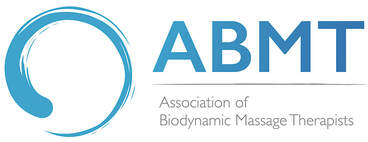 I've literally just come away from our ABMT autumn meeting with Sue Frazer which explored trauma and how to work with trauma. The session started with a sharing of what we thought trauma was and I thought it was helpful for Sue to use the definitions in Babette Rothchild’s book, The Body Remembers, to distinguish between different types of trauma:
It was affirming to know for both sets of therapists that we have a range of different options within our repertoire that we could draw from:
Beyond the specific techniques, we were encouraged to work spontaneously and intuitively by listening to our hands and trusting where our hands take us; also by asking and staying in touch through verbal check-ins and by our presence. We were reminded of the Biodynamic approach as being a ‘bottom-up’ one; it is about staying close to what’s emerging and moving within the client. I thought the discussion on ‘calm and relaxation’ brought up by one of our members was particularly interesting: for clients with anxiety, they can be invited to be in touch with their muscles and the stabilising effect of their muscles. In this context, our intention is to enable the client to sense the difference between ‘tense’ and ‘calm’ and not necessarily to bring them to relaxation in the first instance. Sue also brought in the Startle Reflex and the possibility of working with Lifting as well as using Deep Draining in a gentle way on all the specific muscles engaged in the startle reflex. Where appropriate, Hypotonus Massage techniques to stretch tissues as well as gently inviting energy back in could also be used. The last segment of the afternoon was spent exploring complex and/ or developmental trauma. We were reminded that one of the first things to think about is that when clients come to us, they are longing for touch. It is a fundamental attachment, one of the ways we get to know about this world, about people. Touch, together with what we see with our eyes and what we hear from the voice, these are the fundamental things. I was again reminded of how these three things are so core to our effectiveness as biodynamic therapists. The talk and subsequent discussion was primarily aimed at body psychotherapists in our community who are able to work with complex and developmental trauma. Therapists have to be careful when working with complex trauma. Generally, if the primary issue is that of touch deprivation e.g. premature birth, hospitalisation of mum or baby leading to separation, mum not being available then it may be possible to work with touch early on in the therapeutic process. For clients who experienced physical or sexual abuse then the therapist needs to work more carefully by taking a longer time before it is safe to get close. The question that arose for me was, ‘are we saying that only body psychotherapists can work with complex/ developmental trauma?’. The response was 'yes'. However, it depends on the prior training of the biodynamic massage therapist as to whether they have had any psychotherapy training and/ or trauma training. It also depends on where the client is on their therapeutic journey. If they’ve already had several years of psychotherapy or counselling, they may be able to regulate themselves and have a stronger sense of self. In this case, biodynamic massage therapy could work. It is also possible for biodynamic massage therapists to work alongside talk-based psychotherapists provided the boundaries and contracting is clear with the client. In our work with complex/ developmental trauma, clinical supervision is not only helpful but essential in this territory for both sets of therapists. It was a full and informative afternoon and I had the feeling that two hours was only scratching the surface in relation to the 'what' in working with trauma let alone the scope of 'how' in relation to our individual practices. What I enjoyed most about the time we spent together was being able to listen to the responses and questions from colleagues working in the field and to learn together. As a practitioner, it is something I greatly value because I spend so much of my time working in my own practice. When we have these types of conversations together, it has the effect of opening ourselves up to our collective 'field of practice' and in the process, nourishing ourselves and enriching our practice. To me, this type of sharing is itself a 'bottom-up' experience. As Yvonne said, we are a unique organisation in that we encompass both psychotherapy and complementary therapies. I am hoping that through our ABMT events it will help us grow and develop our uniqueness more. Written by: Amy Barnes
1 Comment
26/12/2023 07:11:21 am
Were there any notable speakers or experts featured in the Trauma Workshop conducted on November 4th?
Reply
Leave a Reply. |
ABMT Blog
A safe place to educate, train and collaborate. Building our network and community. Blog Archives
April 2024
Categories
|

 RSS Feed
RSS Feed